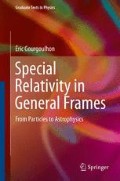Abstract
This chapter introduces the basics of particle description in special relativity, starting by the concept of worldline in Minkowski spacetime. The proper time is then defined as the metric length along a timelike worldline. The concepts of 4-velocity and 4-acceleration of a massive particle are introduced next. The case of massless particles is then contemplated, with the associated notions of null geodesic and light cone. The twin paradox is discussed in depth, via Langevin’s traveller, thereby producing a nice illustration of all the concepts introduced in the chapter. Some experimental realizations of the twin paradox are also presented. The chapter ends with the study of geometrical properties of timelike worldlines.
Access this chapter
Tax calculation will be finalised at checkout
Purchases are for personal use only
Notes
- 1.
Minkowski spacetime is however the arena for relativistic quantum field theory.
- 2.
It is however still not a norm in the mathematical meaning, for it does not satisfy the triangle inequality \(\|\overrightarrow{\boldsymbol{v}} + \overrightarrow{\boldsymbol{w}}\| \leq \|\overrightarrow{\boldsymbol{v}}\| +\| \overrightarrow{\boldsymbol{w}}\|\).
- 3.
Let us recall that the notation \(\overrightarrow{\boldsymbol{u}} \cdot \overrightarrow{\boldsymbol{u}}\) stands for \(\boldsymbol{g}(\overrightarrow{\boldsymbol{u}},\overrightarrow{\boldsymbol{u}})\).
- 4.
As for the 4-velocity, which has not the dimension of a velocity, cf. Remark 2.9.
- 5.
Paul Langevin (1872–1946): French physicist, known for his work on the magnetic properties of materials and Brownian motion. As a friend of Einstein since 1911, he contributed a lot in the diffusion of relativity in France (Paty 1999a). He was also president of the French League of Human Rights from 1944 to 1946.
- 6.
We shall define more precisely the concept of observer in Chap. 3, the present version being sufficient for the purpose of this section.
- 7.
Let us recall that \(\mathrm{d}(\sinh u) =\cosh u\,\mathrm{d}u\) and \(\sqrt{1 {+\sinh }^{2 } u} =\cosh u\).
- 8.
- 9.
An example of such spaces is a torus or, more generally, any compact domain with periodic boundary conditions.
- 10.
We shall make precise the notion of velocity in Chap. 4.
- 11.
If the timelike constraint was relaxed, then \(\mathcal{L}\) could move “backward in time” and t would not be a good parameter along it.
References
Alley C.O., 1983, Proper Time Experiments in Gravitational Fields with Atomic Clocks, Aircraft, and Laser Light Pulses, in Quantum Optics, Experimental Gravitation, and Measurement Theory, by P. Meystre & M.O. Scully (eds.), Plenum Press (New York), p. 363.
Bilaniuk O.M.P., Deshpande V.K. & Sudarshan E.C.G., 1962, “Meta” Relativity, Amer. J. Phys. 30, 718.
Boratav M. & Kerner R., 1991, Relativité, Ellipses (Paris).
Damour T., 2006, Once upon Einstein, A K Peters (Wellesley).
Davies P., 2002, How to Build a Time Machine, Penguin Books (London).
Deheuvels R., 1981, Formes quadratiques et groupes classiques, Presses Universitaires de France (Paris).
Einstein A., 1905c, Ist die Trägheit eines Körpers von seinem Energieinhalt abhängig?, Annalen der Physik 18, 639; http://www.physik.uni-augsburg.de/annalen/history/einstein-papers/1905_18_639-641.pdf Eng. tr. in Beck and Havas (1989), p. 172.
Fayngold M., 2002, Special Relativity and Motions Faster than Light, Wiley-VCH (Weinheim).
Feinberg G., 1967, Possibility of Faster-Than-Light Particles, Phys. Rev. 159, 1089.
Grandou T. & Rubin J.L., 2009, On the Ingredients of the Twin Paradox, International Journal of Theoretical Physics 48, 101.
Hafele J.C., 1972a, Relativistic Time for Terrestrial Circumnavigations, Amer. J. Phys. 40, 81.
Hafele J.C., 1972b, Performance and results of portable clocks in aircraft, in Proceedings of the Precise Time and Time Interval (PTTI) Applications and Planning meeting (16–18 Nov. 1971), U.S. Naval Observatory (Washington), p. 261; http://tycho.usno.navy.mil/ptti/index9.html
Hafele J.C. & Keating R.E., 1972a, Around-the-World Atomic Clocks: Predicted Relativistic Time Gains, Science 177, 166.
Hafele J.C. & Keating R.E., 1972b, Around-the-World Atomic Clocks: Observed Relativistic Time Gains, Science 177, 168.
Landau L. & Lifshitz E., 1975, Course of Theoretical Physics, vol. 2: The Classical Theory of Field (4th edition), Pergamon Press (Oxford); reprinted in 2000 by Butterworth-Heinemann (Oxford).
Langevin P., 1911, L’évolution de l’espace et du temps, Scientia (Bologna) 10, 31; http://diglib.cib.unibo.it/diglib.php?inv=7&int_ptnum=10&term_ptnum=39 Eng. tr.: http://en.wikisource.org/wiki/The_Evolution_of_Space_and_Time
Laue M., 1907, Die Mitführung des Lichtes durch bewegte Körper nach dem Relativitätsprinzip, Annalen der Physik 23, 989; http://gallica.bnf.fr/ark:/12148/bpt6k153304.image.f993 Eng. tr.: http://en.wikisource.org/wiki/The_Entrainment_of_Light_by_Moving_Bodies_According_to_the_Principle_of_Relativity
Lehoucq R., 2004, Voyager dans le temps?, Pour la Science 326, 140.
Marder L., 1971, Time and the Space-Traveller, George Allen & Unwin (London).
Minkowski H., 1908, Die Grundgleichungen für die elektromagnetischen Vorgänge in bewegten Körpern, Nachrichten von der Gesellschaft der Wissenschaften zu Göttingen, Mathematisch-Physikalische Klasse 1908, 53; reprinted in Mathematische Annalen 68, 472 (1910); http://resolver.sub.uni-goettingen.de/purl?GDZPPN00250152X Eng. tr.: http://en.wikisource.org/wiki/The_Fundamental_Equations_for_Electromagnetic_Processes_in_Moving_Bodies
Minkowski H., 1909, Raum und Zeit, Jahresberichte der deutschen Mathematiker-Vereinigung 18, 75; reprinted the same year as a book by B.G. Teubner (Leipzig et Berlin); http://de.wikisource.org/wiki/Raum_und_Zeit_%28Minkowski%29; Eng. tr. in Lorentz et al. (1923), p. 73, and in http://en.wikisource.org/wiki/Space_and_Time
Møller C., 1952, The Theory of Relativity, Oxford University Press (London); http://www.archive.org/details/theoryofrelativi029229mbp
Paty M., 1999a, Paul Langevin (1871–1946), la relativité et les quanta, Bulletin de la Société Française de Physique 119, 15; http://halshs.archives-ouvertes.fr/halshs-00181587
Poincaré H., 1898, La mesure du temps, Revue de Métaphysique et de Morale 6, 1; reprinted as Chapter II of Poincaré (1905a). http://www.univ-nancy2.fr/poincare/bhp/pdf/hp1898rm.pdf Eng. tr.: http://en.wikisource.org/wiki/The_Measure_of_Time
Poincaré H., 1906, Sur la dynamique de l’électron, Rendiconti del Circolo Matematico di Palermo 21, 129; http://www.soso.ch/wissen/hist/SRT/P-1905.pdf reprinted in Poincaré (1924), p. 18 and in Poincaré (1954), vol. 9, p. 494; selected parts reprinted in Rougé (2008); Eng. tr.: http://www.univ-nancy2.fr/poincare/bhp/pdf/hp2007gg.pdf (excerpts) http://en.wikisource.org/wiki/On_the_Dynamics_of_the_Electron_%28July%29
Recami E., 1987, Tachyon kinematics and causality: A systematic thorough analysis of the tachyon causal paradoxes, Foundations of Physics 17, 239.
Thorne K.S., 1994, Black Holes and Time Warps: Einstein’s Outrageous Legacy, Norton (New York).
Uzan J.-P., Luminet J.-P., Lehoucq R. & Peter P., 2002, The twin paradox and space topology, Eur. J. Phys. 23, 277.
Author information
Authors and Affiliations
Rights and permissions
Copyright information
© 2013 Springer-Verlag Berlin Heidelberg
About this chapter
Cite this chapter
Gourgoulhon, É. (2013). Worldlines and Proper Time. In: Special Relativity in General Frames. Graduate Texts in Physics. Springer, Berlin, Heidelberg. https://doi.org/10.1007/978-3-642-37276-6_2
Download citation
DOI: https://doi.org/10.1007/978-3-642-37276-6_2
Published:
Publisher Name: Springer, Berlin, Heidelberg
Print ISBN: 978-3-642-37275-9
Online ISBN: 978-3-642-37276-6
eBook Packages: Physics and AstronomyPhysics and Astronomy (R0)

